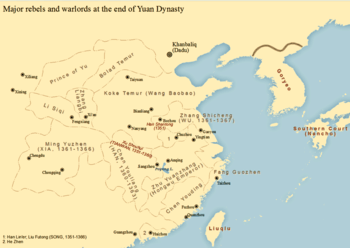Zhou (Zhang Shicheng's kingdom)
The Kingdom of Great or Greater Zhou (Chinese: 大周, pinyin: Dà Zhōu; 1354–1367) was a state established in 1354 by Zhang Shicheng,[1] one of the leaders of the Red Turban Rebellion. The Kingdom of Dazhou lasted for only 13 years and had only one King.
Great Zhou 大周 | |||||||||
|---|---|---|---|---|---|---|---|---|---|
| 1354–1367 | |||||||||
| Status | Kingdom | ||||||||
| Capital | Suzhou (1356–1367) | ||||||||
| Common languages | Chinese | ||||||||
| Religion | Buddhism, Taoism, Confucianism, Chinese folk religion | ||||||||
| Government | Monarchy | ||||||||
| King | |||||||||
• 1354–1367 | Zhang Shicheng | ||||||||
| History | |||||||||
• Established | 1354 | ||||||||
• Disestablished | 1367 | ||||||||
| Currency | Chinese coin, Chinese cash | ||||||||
| |||||||||
| Today part of | China | ||||||||
Founding
Since the 1340s, the Mongol-ruled Yuan dynasty began to face numerous crises. The Yellow River flooded constantly, and other natural disasters also occurred. At the same time, the Yuan dynasty required considerable military expenditure to maintain its vast empire. This was solved mostly through additional taxation that fell mainly on the Han Chinese population which constituted the lowest two castes in the four castes of the Yuan dynasty. From this chaos, leaders arose from many places throughout the empire. Zhang Shicheng, who was a salt shipper from Jiangsu province rebelled against the Yuan dynasty in 1353. Zhang with his brother soon conquered Taizhou, Xinghua and Gaoyou in 1353.
In 1354 Zhang established Kingdom of Dazhou and declared himself as king with era name Chengwang (诚王). Soon afterward, on the same year Zhang controlled Yangzhou, an important center of salt trade on the Grand Canal (China), just north of the Yangtze. In 1356 Zhang seized Suzhou, the main hub of transportation and commerce of Jiangnan (the "South of the Lower Yangtze" region), and made the city his capital. Zhang appointed his brother Zhang Shixin as prime minister and Zhang Shide as General commander. Many ethnic Han Yuan generals submitted to Zhang after he had established the Kingdom of Dazhou.
Economy & culture
_-_3_Cash_-_Scott_Semans.jpg)
Kingdom of Dazhou was one of the country's main granaries and also produced over half of all salt in China. Dazhou became the most prosperous kingdom compared to its rivals such as the Yuan, Zhu Yuanzhang and Chen Youliang. Zhang's regime was mostly patterned on the Yuan dynasty model, but made use of some of the earlier traditional Chinese terminology as well.
Decline & fall
By 1366, Zhu had conquered most of the various rebel kingdoms in the Yangtze region, and in December his army reached Suzhou, capturing it on October 1, 1367, after a 10-month siege.
References
Citations
- Needham, Joseph; Ling Wang Science and civilisation in China, Volume 4, Part 1 Cambridge University Press; 1 edition (8 May 2008) ISBN 978-0-521-87566-0 p. 292
Sources
- Edward L. Farmer, Zhu Yuanzhang and Early Ming Legislation: The Reordering of Chinese Society Following the Era of Mongol Rule. BRILL, 1995. ISBN 90-04-10391-0, ISBN 978-90-04-10391-7. On Google Books. p. 23.
| Preceded by Yuan dynasty |
Dynasties in Chinese history 1354–1367 |
Succeeded by Ming dynasty |
